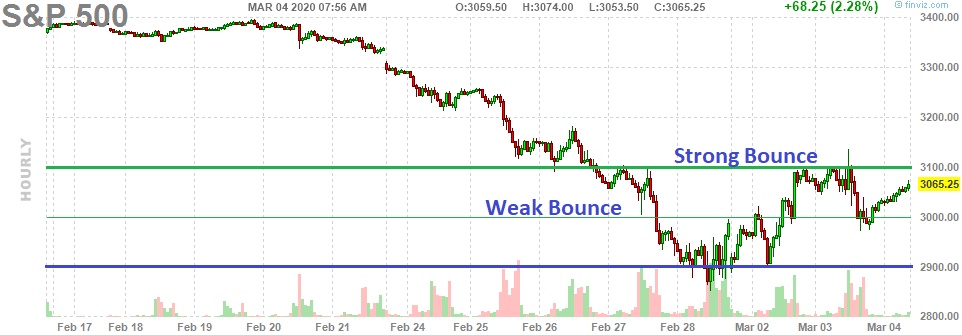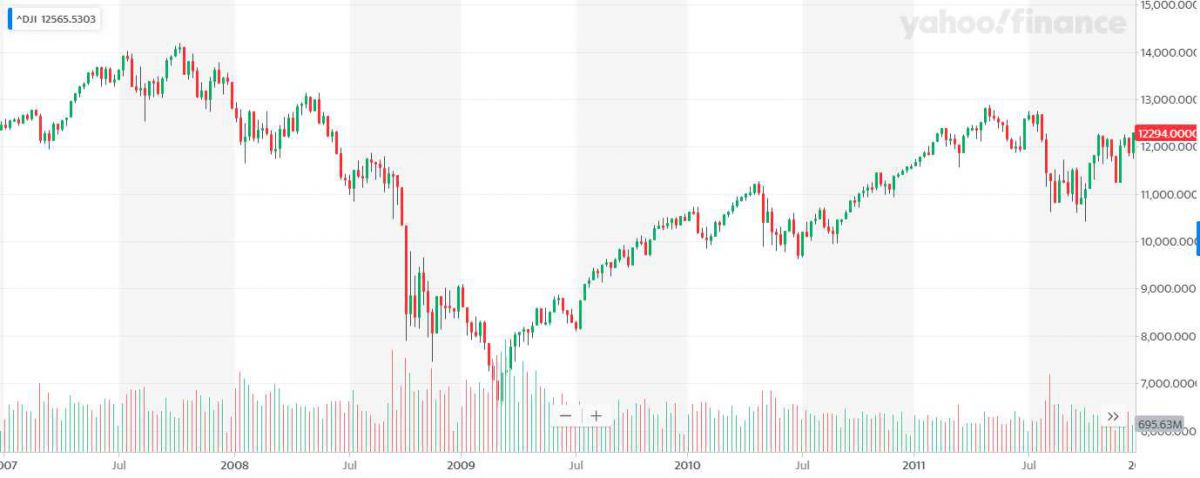 Notice we're not playing the Futures this week.
Notice we're not playing the Futures this week.
Last week, we were racking up $5,000 gains almost daily with our Futures calls but this week the market is just as wild but nowhere near as predictable due to Fed interference against the still MASSIVE UNCERTAINTY surrounding the virus. As I often say to our Members:
"We only like to play when we feel there's an 80% chance we will win – that way, we're only wrong about half the time and good money-management techniques can take care of the rest."
So far, the S&P and the other indexes are simply consolidating under the Strong Bounce Lines (see yesterday morning's PSW Report for official levels) and, if they make a move over, it will be good proof of a bottom but, if they make a move back below last week's lows then, in retrospect, it will be very obvious that they were only consolidating for another 10% move down.
Is the Fed's 0.5% rate cut enough to save us? Well it wasn't when they had emergency rate cuts in August of 2007 (Dow 13,000 to 14,000) or in January of 2008 (Dow 12,000 to 13,000) or in October of 2008 + $800Bn TARP (Dow 8,000 to 9,000) – after which we fell from 9,000 back to 6,666 so forgive me if I don't get too excited about a 1,000-point, stimulus-driven bounce this week…

Another thing I discussed with our Members yesterday was how the Dow Jones has been manipulated since 2008 when Rupert Murdoch took over the company and made a series of changes that drastically boosted the index. Bearing in mind that each Dow Component is price-weighted, not market-cap weighted, and adds 8.5 Dow points per $1 in share price – these are the substitutions that have been made under Murdoch:
- AAPL (now $295) replaced T (now $37)
- CSCO ($41) replaced C ($66)
- TRV ($127) replaced GM ($31)
- UNH ($268) replaced KHC ($26
- GS ($206) replaced AA ($13)
- NKE ($93) replaced BAC ($28)
- V $190 replaced HPQ ($20)
- WBA ($47) replaced GE ($11)
That's net +$1,035 in substitutions and, at 8.5 points per Dollar, those manipulations have artificially added 8,797 points to the Dow or 1/3 of it's total "value". At 26,432, if we subtract the fake gains, the original Dow Components of 2008 would have us at only 17,635 – up about 20% from the pre-crash highs of 14,000.
As we all know, the Dow is the headline index that drives the markets around the World. Although it's idiotically price-weighted and only has 30 hand-picked stocks, people don't ask how the S&P or the Nasdaq did yesterday – they want to know how many points the Dow gained or lost. That's especially true in foreign countries but, even in the US, the vast majority of people (even traders) watch the Dow.

So, when Rupert Murdoch bought the Dow Jones corporation in 2008 for $5.6Bn, he took control of the index that drives the markets as well as the narrative that surrounds it (the Wall Street Journal) and that combination has allowed Murdoch to manipulate his own net worth from $4Bn in 2009 to $20Bn today.
 The fact that Billionaires control the media and the markets isn't news, of course but it is important when you consider the current narrative that the markets should recover their previous highs – especially when the Billionaire-owned MSM uses the Dow to illustrate the "value" of the markets.
The fact that Billionaires control the media and the markets isn't news, of course but it is important when you consider the current narrative that the markets should recover their previous highs – especially when the Billionaire-owned MSM uses the Dow to illustrate the "value" of the markets.
Just keep in mind it's a total load of crap because they are not comparing the same stocks that were in the index in the past and that 40% of the last decades move up has come from manipulation having nothing at all to do with increasing value of the components – the whole thing is a false premise and DON'T tell me these guys aren't smart enough to know that – they are simply lying to you!
Every Billionaire that owns every media outlet WANTS you to be bullish on the market. That's why the financial media is nothing put a squad of cheerleaders who will say or do anything to get you to BUYBUYBUY – even when common sense tells you clearly not to. They are high-pressured salespeople pushing over-priced products you neither want or need to please their Billionaire bosses, who own 84% of the wealth represented by those stocks.
We are starting to pick up some bullish positions but we remain cautious and well-hedged – especially while the indexes are still under their strong bounce lines and, since they need to hold above them for 2 straight days without going under to be truly bullish – it's going to be impossible for us to be bullish into the weekend so, for the most part – we remain on the sidelines this week enjoying the show.



